Sequelitis- the disease that franchises get whenever there is a needless sequel green lit and produced. The trope was codified by the Land Before Time movie franchise. The original film, The Land Before Time, was a classic animated film by that guru of animation, Don Bluth, about five dinosaur children that seek to find their families while avoiding being eaten alive by a T-Rex. It is a surprisingly dark film, brilliantly animated, and one of the greatest films of all time. Land Before Time 2 was a direct to video sequel that was about those same five children discovering a T-Rex egg, and returning it to its parents. The sequel was...not as good. And then they made another film that was a little worse than that one. And another. And another. By the time I was in college, they made the eleventh film in the series. None of these sequels were truly needed, and were made only to make a quick buck. But I digress; this blog isn't about Land Before Time, this entry is about the classic Super Nintendo game, Donkey Kong Country, and its sequels.
The original Donkey Kong Country was a fun platforming game. You played as Donkey Kong, a gorilla who is out to regain his stolen banana hoard from the greedy crocodile, King K. Rool. Along the way, Donkey is aided not only by his little monkey pal Diddy Kong, but also by a few animal buddies, which both Donkey and Diddy could ride on. These animals were:

Rambi the Rhino
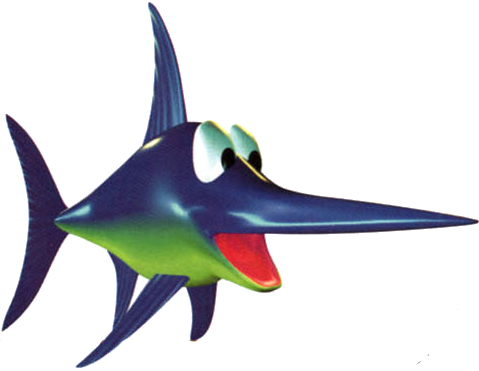
Enguarde the Swordfish

Espresso the (useless) Ostrich

and Winky the (useless but not as useless as Espresso) Frog
The plot was very thin, and most bosses were simply palette swaps of each other. In fact, only three of the seven bosses had original designs: Dum Drum, Queen B, and King K Rool. There were no timers, so you could beat any stage at your leisure. There was, in fact, quite a lot of variety in levels. You had the classics like caverns, jungles, underwater, forests, and ice zones. But you also had some originality thrown in, like factory levels where the lights would go on and off, or perhaps the most famous innovation the game had ever made, levels where you ride a mine cart in a high speed run. The game was divided in six stages. The first was the Kongo Jungle, whose levels were mostly jungle, with one cavern and one underwater level. The second stage was Monkey Mines, a stage balanced by a few cave, mine cart, and temple levels. The third, and my favorite, was Vine Valley, which had mostly a forest theme to it. The fourth was Gorilla Glacier, which was mostly ice themed. The fifth and most memorable was Kremcroc Industries Inc, which had a pollution theme. And then there were the Chimp Caverns, which were mostly caves, and very disappointing. After fighting through the stages, you faced the final Boss: King K Rool.
Although Donkey Kong Country's graphics, which were a big deal and technologically innovative back in 1994, have not aged too well, the game's game play was very solid and fun. It was easy to pick up and play, yet challenging enough to keep you hooked.
The theme of the game, subtle as it was, was the destruction of nature caused by industry. This is made most glaring by the contrast between the first four stages of the game (Kongo Jungle, Monkey Mines, Vine Valley and Gorilla Glacier) and the fifth (Kremcroc Industries Inc). Kremcroc Industries stands out from the rest of the game by how filthy and bleak it is, in contrast to the lively earlier stages of the game, especially Kongo Jungle and Vine Valley. Another major theme in the game is the beauty of nature. Make no mistake, this game is gorgeous, and every level is incredibly detailed.

This looked way cooler back in 1994.
Donkey Kong Country 2 took everything the original game did well, and added more. The game got rid of Winky and Espresso, which were unwieldy and generally not too useful, and replaced them with three new buddies. They were:
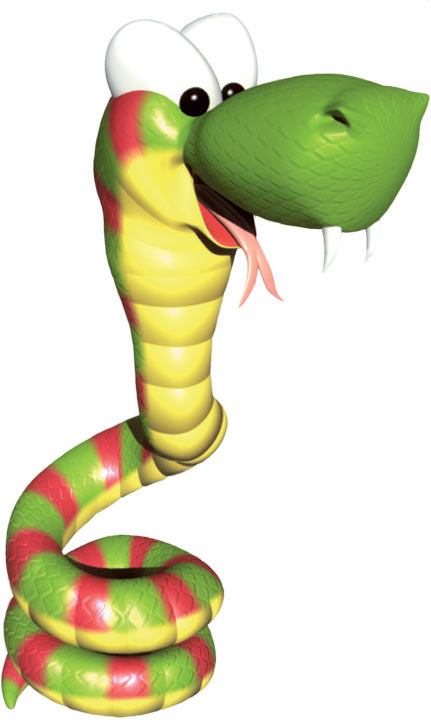
Rattly the Snake
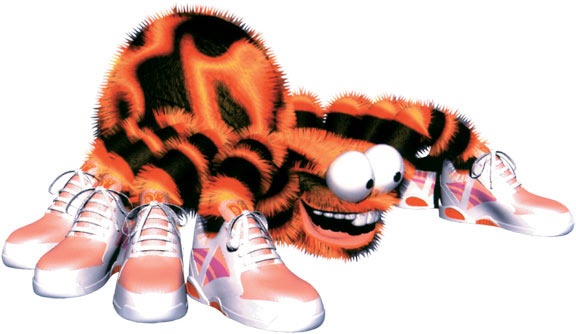
Squitter the Spider
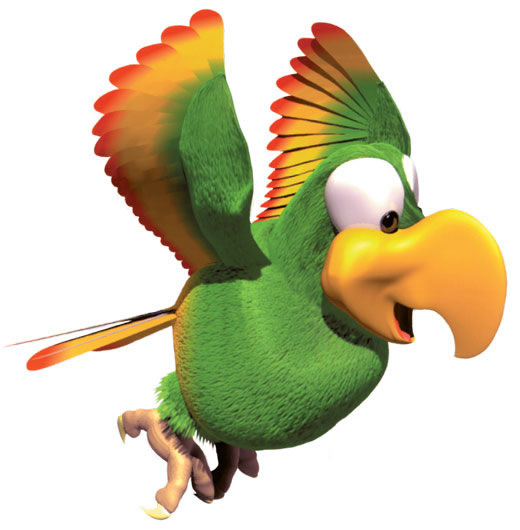
And Squawks the Parrot
The game's plot was just as thin as the original. K Rool, this time calling himself Kaptain K Rool (yes, that's how it's spelled) has kidnapped Donkey Kong, and now it's up to Diddy Kong himself to save his big buddy. Joining him is his girlfriend, Dixie Kong, as they trek through the dangerous Crocodile Isle. The game had a bigger variety in zones than the original did. There was the Gangplank Galleon, a pirate ship themed stage, Crocodile Cauldron was caves and volcanoes. Krem Quay was swamps and shipwrecks. Krazy Kremland was a combination of a few swamps, an abandoned amusement park, and giant bee hives. And then there was Gloomy Gulch, a stage evenly split between haunted houses, ghost infested forests, and a bee hive. The second to last level was K Rool's Keep, a castle stage with some ice caverns thrown in. And finally, the Flying Croc, where you faced Kaptain K Rool in what had to be the best boss fight the series had offered up until that point. Ah, but there was also a secret stage, the Lost World, that could only be accessed by completing bonus stages in the game. The Lost World was mostly jungle levels, and beating this stage gave you 100% completion of the game and a secret ending.
DKC2 was a vast improvement over the original. Although the graphics were the same, and the game play was so similar as to seemingly have changed very little, there was a lot to love in this game. There was more balance between the animal buddies, giving them each a special use. Rambi was good at plowing through enemies, while Rattly was better at making high jumps. Squitter was great at crossing long chasms, while Squawks was good at flying. And Enguarde dominated the underwater levels. In contrast, Espresso was not very good at anything, and in fact most of the time was a hindrance. Winky was good at making jumps, but he was impossible to control well, and was slower than Donkey and Diddy. Donkey Kong Country 2 did away with both of them, and was all the better for it. The addition of bonus levels and a secret stage meant that there was a higher incentive to replay each stage, and a better challenge. What's more, of the six bosses in the game, only two are palette swaps of each other, and in fact it could be justified: There was Krow, the first boss, and the fifth boss, Kreepy Krow, Krow's ghost. K Rool's Keep didn't have a boss, but since the stage had really hard levels, this is somewhat excused.
A major theme to Donkey Kong Country 2 was abandoned areas. Gangplank Galleon is a sinking pirate ship. Crocodile Cauldron and Krem Quay have shipwrecks prominently featured. Krazy Kremland is an abandoned amusement park, overrun by beehives, swamps and bramble. Gloomy Gulch has several abandoned houses. K Rool's Keep also seems to have no one tending to it. Another theme was piracy, supported by how many pirate ships there are in the game (3), and how three of the six bosses are styled like pirates: Krow, Kreepy Krow, and Kaptain K Rool. A funny element in the game is that every boss' name starts with K: Krow, Kleever, Kudgel, King Zing, Kreepy Krow, and Kaptain K Rool.
And this is where the series got hit hard with sequelitis. While Donkey Kong Country 2 was a vast improvement on the original, Donkey Kong Country 3, was, well...
The plot of DKC3 was that, while on vacation in the Northen Kremisphere, Donkey and Diddy got kidnapped, so now it's up to Dixie Kong and her cousin, Kiddy Kong, to save...
Let me just stop right there, because that's the first sign of sequelitis. This story is a rehash of the second game. Kidnappings? They did that already! And in fact, having Donkey Kong get kidnapped in the second game was stretching the suspension of disbelief, because Donkey Kong had beat K Rool before! And now you're telling me he got kidnapped again? AGAIN??? Yeah I can believe that with Princess Peach, but with Donkey Kong? Do you even know who that gorilla is?

Does this look like Princess Peach to you?
Anyway, the Northen Kremisphere is a, well...valley? Continent? It's never clear just WHAT this place is. We know it has a lake, a forest, an island, a beach, and a canyon. But is it an island? A continent? I have no idea. For the sake of sanity, I'm going to call it an island. Anyway, there are eight stages. The first is Lake Orangutanga, self explanatory. The Second is Kremwood Forest, again self explanatory. Third is Cotton Top Cove, which is mostly lakes and waterfalls. Fourth is Mekanos, an industrialized island. Fifth is K3, a snowy mountain. Sixth is Razor Ridge, which is mostly cliffs. Seventh is KAOS Kore, where you fight the final boss of the game, Baron K Roolenstein (you can groan with exasperation, I sure did.) And finally, the secret stage, Krematoa, an inactive volcano.
The game did away with Rambi the Rhino and Rattly the Snake. That alone is anathema, because Rambi was a fan favorite. Instead we get...

Ellie the (goddamn) Elephant.
There was no need to remove Rambi. Rambi was great. Rambi was iconic. Ellie can jump, pick up barrels, and shoot water out of her trunk. Rambi can charge at you and hit you with his horn. Rambi > Ellie.
And also, there was Parry the Parallel Bird, who was useless. All he did was collect stuff that was above the Kong's heads, out of their reach. You couldn't even ride him, because of how small he was. Here's a picture of him:
To scale
Part of what made the third game so disappointing was just how little it truly added to the series. That's not to say there was nothing good, far from it. Many levels were fun and challenging, and many had amazing concepts, especially the cliff side levels. But for every good concept, there was something else that brought the game down. Lakeside levels were boring and easy. Levels with Ellie in them were often boring, Squitter was rarely usable. There were two side quests added, but it is questionable if they were truly needed. I certainly didn't feel satisfied finishing them. And one of these side quests was trading items between stages. I didn't like it.
One of the most disappointing elements of the game was Kiddy Kong himself. Part of what made Donkey Kong Country 2 so good was that Dixie was a very unique character, with her own uses that separated her from Donkey and Diddy. She could spin around in the air, hovering safely, which made certain jumps and one boss far easier. Kiddy, on the other hand, plays almost exactly like Donkey. Instead of holding barrels over head, Kiddy held them in front of him. And...that's pretty much it.
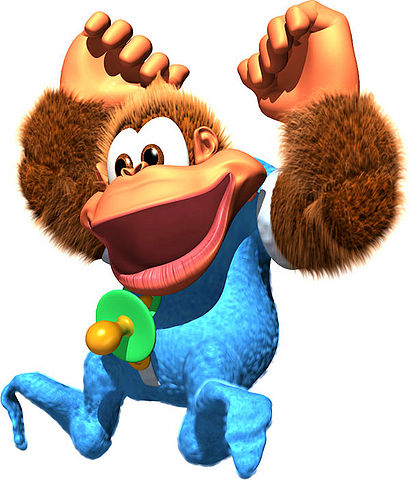
Kiddy is also an over sized baby.
The theme? There was none. At least, no new themes that hadn't already been explored previously. There's the destruction of nature by over industrialization, as explored in Mekanos (and only in Mekanos). There's also the beauty of nature, as explored by...the rest of the levels. Thematically, this game is just a clone of the first. Thing is, the first game already did it well enough. In fact, you could argue that the first game did it better, by mere virtue of showing Kremcroc Industries Inc as a polluted hellhole, while Mekanos is an island that still has a ways to go before it is completely decimated.
One thing this game has going for it is that each boss is unique. Most of them require strategy to beat, instead of simply "hit them on the head when they are vulnerable" like the first game. But this is something the second game had already done.
The music? Well, there were some brilliant tracks, to be certain, but there were also some that were terrible. The boss fights were almost ruined by slow background music. And the final boss? A good fight, so so music. And this is truly more disappointing by how AWESOME the final boss tunes were in the first two games. Let me show you:
The final boss music from DKC1
The final boss music from DKC2
The final boss music from DKC3
I leave it to you to decide which one is better. My personal favorite? The first, but the second has many strong points.
Part of what breaks my heart is that, until the third game, the Donkey Kong series was one of the best franchises of the Super Nintendo, which codified how great a game could look in the system. This game, along with Star Fox, was showing the world that the Super Nintendo was the best machine there was to play games in, pulling out graphics and game play that no other system out there could even dream of doing without putting in super expensive computer chips. Unfortunately, Donkey Kong as a franchise would begin to sink from this moment onward, going from one of the leading figures in gaming, to a washed up has been that became reliant on gimmicks to stay afloat. It would not be until Donkey Kong Country Returns, for the Nintendo Wii, where the franchise would return to its platforming roots.
No comments:
Post a Comment